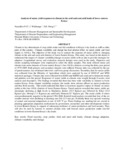| dc.description.abstract | Climate is key determinant of crop yields under rain fed conditions in Kenya’s dry lands as well as other
parts of the country. Climate variability and change has had adverse effect on maize yields and food
supply in ASALs. The objective of the study was to analyze the response of maize yields to changing
climate in the arid and semi arid districts of lower Eastern Kenya. This study was based on the desire to
understand the impact of climate variability/change on maize yields with an aim to provide strategies for
adaption. Longitudinal survey and evaluation research designs were used in the study. Purposive and
cluster sampling techniques were employed to select the study samples. The study utilized maize and
climate time series datasets of lower eastern Kenya’s four ASALs districts covering the thirty year period
of 1979-2009. Both primary and secondary datasets were utilized. Primary data was collected by the use
of questionnaires, key informant interviews and focus group discussions. Secondary data for maize yields
was collected from the Ministry of Agriculture which were analyzed by use of INSTAT and SPSS
statistical packages. Climate data were collected from KMD and KEFRI and analyzed to determine trends
and patterns over the period. Responses of maize yields to climate were sought through Z-scores, tend
analysis and descriptive. The findings revealed that there has been wide variability in climate in lower
eastern Kenya. From climate variability analysis, the results show adverse effects on maize production
and thus food security. The results indicated that there is enormous negative impact of climate on maize
yields in the four ASAL districts of lower Eastern Kenya. Trend analysis revealed that maize yields are
alarmingly declining at high levels in Machakos district (22.5 Kg/acre pa) followed by Kitui (12.0
Kg/acre pa), Mwingi (7.3 Kgs/acre pa) and lastly Makueni 8.7 Kg/acre pa). The maize yields Z-values
were predominately negative in the period 1994-2008. Rainfall trend analysis revealed that four of the six
weather stations were declining at alarming rate (0.6-15.5 mm pa). Evidently there was upward warming
of annual and seasonal temperature at rate of 0.03 0C pa. These findings are startling but are crucial in
planning appropriate adaptation mechanisms by government, researchers and other development workers
in lower Eastern Kenya in support of enhancing resilience of maize production and food security. They
will also be used by farmers to monitor climate risks and forecast maize production under rain-fed
conditions in lower Eastern Kenya’s dry lands. | en_US |

